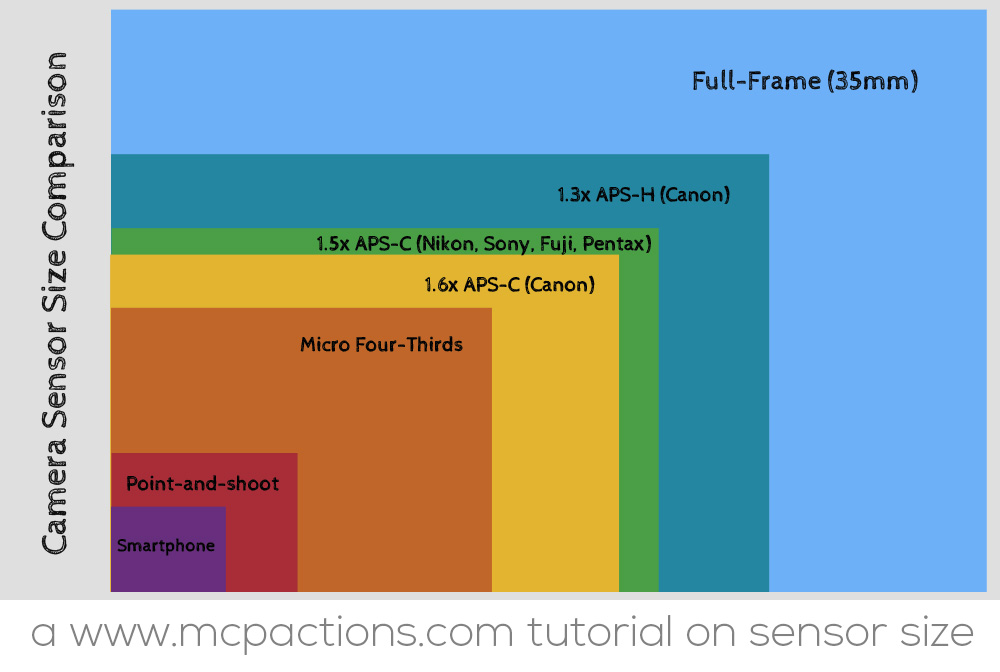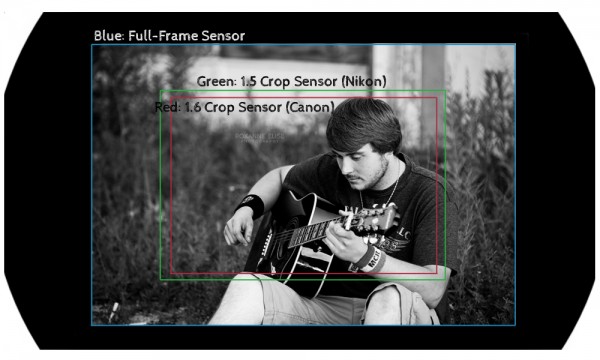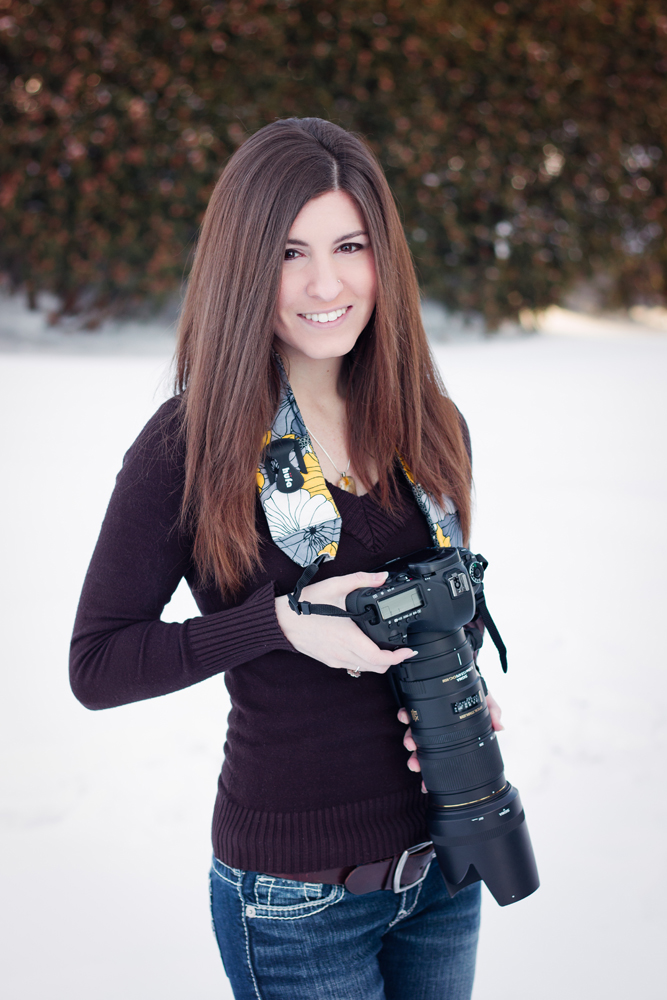Featured Products

If you are new to photography, or starting to think about upgrading your camera equipment from entry-level gear to something more professional, you may be confused about what crop sensor vs. full-frame really means and how it affects your photography.
First, what is a sensor?
The sensor is the electronic device that records information when the photo is taken. Sensors replaced film and are affected by light entering the camera through the lens. The light-sensitive “pieces” that capture this information are called photosites. Increasing the ISO setting on your camera makes the sensor more sensitive to light it receives. Higher ISO will introduce more noise and grain into an image.
Sensor size can impact the quality of your photographs.
The short story is that sensors come in different physical sizes. A larger sensor can record more information (it has more photosites), giving you the potential for a better photo, especially when compared at high ISO settings. (But, this isn’t always the case- the technical quality of a photo depends on many factors!) A smaller sensor can limit a photographer in some cases, especially in low light. The sensor size’s other major effect is how much of the scene can be viewed and photographed by the camera from a certain focal length and certain distance to the subject.
Many entry-level DSLR cameras are crop-sensor cameras. Most, but not all, professional or high-end camera bodies are full-frame. Other cameras, such as micro four-thirds and point-and-shoot cameras, have comparably much smaller sensors. And smartphones have sensors that are even smaller. As most of us know, compact cameras and smartphones usually perform much more poorly, especially in low light. Photos often include more grain and less sharpness. The tiny sensor is one reason for that. Sensor size has a much greater effect on the quality than megapixels do, even though everyone seems to be hung up on megapixels these days. Without a large enough sensor, even 30 megapixels won’t do you any good. However, compact cameras and smartphones are beginning to boast larger sensors, though they will never quite rival a DSLR camera.
Comparing common sensor sizes… and how they affect the focal length of your lens.

A full-frame sensor mimics the size of a frame of 35mm film. This is considered the standard sensor size in the photography industry. Cropped sensors (APS-C) are quite a bit smaller in size than full-frame sensors. As you can see, Canon uses a slightly smaller sensor size for their APS-C bodies than do Nikon, Sony, Fuji, and Pentax. (I use Canon and have both a crop-sensor and a full-frame body).
The multiplication factor is used for multiplying your focal length when using a crop-sensor camera to get the “equivalent” focal length (in respect to angle of view of your lens) as if you were shooting with a full-frame camera. Canon’s APS-C multiplication factor is 1.6x, while Nikon/Sony/Fuji/Pentax’s APS-C multiplication factor is 1.5x. An APS-H camera with a 1.3x multiplication factor (exclusive to Canon) has a sensor size in between APS-C and full-frame. From my reading, I believe it was Canon’s move to make a more affordable camera that still utilized a larger sensor than the crop bodies. A micro four-thirds sensor with a crop factor of 2x is used on some mirrored and mirrorless interchangeable-lens bodies on the market that bridge the gap between compact cameras and crop-sensor DSLRs. Bigger than full-frame are medium-format and large-format cameras, but these are not as popular on the market and are a LOT more pricey.
To break it down, this multiplication factor means:
- On Canon APS-C bodies: 35mm lens = equivalent focal length to 56mm on full-frame.
- On Nikon/Sony/Fuji/Pentax APS-C bodies: 35mm lens = equivalent focal length to 53mm on full-frame.
- On a full-frame body, 35mm is considered a wide angle of view. On an APS-C body, it falls more in the “normal” angle of view range.

This image was shot with a full-frame camera. The angle of view was wide enough to include my subject and surrounding objects. If I shot it with a crop-sensor camera, standing at the same distance and using a lens with the same focal length, I would not have been able to capture as much of the scene in the photo, as if I had zoomed in, creating a narrower angle of view. I would have needed to use a shorter focal length and/or increase the distance between the subject and myself.
There are advantages and disadvantages to each sensor size.
The advantages to full-frame, as touched on earlier, are that there are more photosites to record more information. This is a huge advantage when shooting in low light. The amount of noise and grain is minimal at higher ISO sensitivities than compared to a crop-sensor camera. This allows a photographer to use natural and ambient light more effectively to produce the image with good exposure while remaining sharp and noise-free. They can increase the ISO without too much degradation of image quality. For instance, on my full-frame camera (Canon 5D Mark III) I can push the ISO to 2000 and still get an acceptable amount of noise and grain, and the grain seems to be of a finer size. On my crop-sensor body ( Canon Rebel T2i ) I don’t like to shoot with the ISO over 400 because it produces much more noticeable noise and grain. The other advantage is that you don’t have to do the math to figure out what your focal length is when shooting. What you see is what you get. A wide-angle lens will be a wide-angle lens, and when using a long focal length you won’t have to back up far to take a full-body portrait. Disadvantages include making the camera a bit larger and heavier, and needing larger and heavier lenses. Full-frame cameras are also much more expensive. Overall, full-frame cameras have a higher ability to produce an image of better technical quality.
Crop-sensor cameras do have some advantages. First of all, they are not as expensive. They are great for photographers to start out with due to the price. It’s not as big of an investment for when you are still discovering what type of photography you want to do. While I’m not sure about other brands, I know that Canon produces a lineup of lenses that are made only for their crop-sensor bodies and they are much less expensive than the rest of their lenses. Canon EF-mount lenses fit all of their bodies, while EF-S mount lenses only fit crop-sensor bodies due to a protruding piece on the back of the lens where it attaches to the body. This protrusion would actually hit the larger reflex mirror on a full-frame body, so never mount this lens on your full-frame! Another advantage is that you get “more lens for the length.” If you want to shoot more distant subjects, a shorter focal length will effectively (or optically) zoom in even closer. If you only have a 50mm lens and want to shoot more flattering portraits, it is effectively 80mm/75mm (depending on camera brand). Last summer I shot a photo of the moon at night and opted to use my crop-sensor body with my 70-200 lens. Zooming in all the way to 200mm, with the crop factor, my lens gave me a slightly closer view of the moon as if it were 320mm on a full-frame camera.
What about depth of field?
Depth of field is how much of your image is acceptably sharp and in focus. Many portrait photographers prefer a shallow depth of field to isolate their subject from the background. Sensor size does affect depth of field. If you are taking a photo of a subject at the same aperture and focal length, you will have to back up quite a distance or use a shorter focal length when using a crop-sensor camera to get the same amount of the subject in the frame. Being closer to your subject and/or using a longer focal length generally will produce a shallower depth of field, and a full-frame camera will allow for this. A crop-sensor camera may not give you the same shallow look you are trying to achieve.
Do I need to upgrade to a full-frame camera?
The short answer: Not necessarily. It all depends on the type of photography you wish to do. Having a full-frame camera is not what will make you a professional. Some professionals even opt to stick with crop-sensor cameras. Given the right conditions, a crop-sensor camera can produce images of equal or better quality. This usually depends on whether or not there is adequate lighting, and what quality of lens is used. (In fact, the quality of lens can have a much greater effect on the outcome of a photo than the camera body.) If you feel that your entry-level camera body is limiting you, it may be time to upgrade to a high-end full-frame body. While I no longer use my crop-sensor camera for professional shooting, I do use it plenty for other applications. Because it was not very expensive, I have felt more freedom to take it with me on adventures that could potentially cause damage to my equipment (like, last summer I took it canoeing on a river.)
My full-frame camera is my powerhouse for portrait sessions and weddings, and allows me the freedom to shoot indoors and on very cloudy days and still get better image quality. It not only has a larger, higher-quality sensor, but is also built better all around and is made with a stronger autofocus system. However, I have seen some breathtaking photos taken by photographers (both professionals and hobbyists) with entry-level cameras, because they are able to nail the exposure. It is good to challenge yourself to get the good shots with the camera you already have, and then upgrade once you feel you can’t get the shots you want with your current gear. Depending on the type of photography you do, and how much light is available to you, a crop-sensor body may be adequate. When you are just starting out I recommend purchasing a crop-sensor body. In my experience, I would recommend a full-frame camera for a professional photographer.

Roxanne Abler (Roxanne Elise Photography) is a photographer from Fond du Lac, WI who enjoys shooting portraits as well as everything else that makes for an interesting photograph. She started photographing things at a young age using disposable cameras, and then developed her interest in college photography courses and also while working as a photographer’s assistant.
She has been shooting professionally for about two years. She also works in sales/marketing at a manufacturing company. One of her favorite subjects to photograph are old, abandoned buildings. Check out her website and Facebook page.
No Comments
Leave a Comment
You must be logged in to post a comment.







































Great article for clearly explaining the differences in the two sensor types. Seems I have to explain this to a new co-worker who is looking at buying a camera every few months – I’ll just send them here now! One subtle point that is usually not discussed is that even though there is an equivalent focal length in a cropped sensor, optically, the lens is the same. For example, using a 35mm lens on an APS-C camera produces an equivalent field of view of a 56mm lens, but will still have the perspective of a 35mm lens. What (size sensor) you are projecting your image on has no effect on the optics. So, if you are comparing these two cameras at the same distance from a subject and making similar photos, the APS-C shooter will be wider, which may or may not be desired.
Nikon also produces a line of lenses that work only on the crop frame cameras and are significantly cheaper than the lenses that also work on the full frame.
Great article – thank you. I was just reading on the mcp facebook page about this and had no idea what they were talking about. Now i know! another great reason why i love following mcp actions.
Sorry, full frame sensors do NOT have “higher-quality sensor”. The size of the sensor has nothing to do with the quality of the sensor. And focus systems also have nothing to do with sensor size. My D7100 AF is just as good as my D600. And if you want to be able to have a larger area of focus a cropped sensor AF covers more of the frame.Full frame cameras have a slight advantage with lower high ISO noise. A bigger and brighter viewfinder. Wider angle of view with lenses. And the ability for shallower depth of field.There are many cropped frame cameras that are not “entry-level cameras”.I find your assertion that cropped frame cameras are some how inferior to full frames miss leading and snobbish.One of the leading reasons full frames cost more is the greatly increased cost to manufacture full frame sensors.There are reasons to buy or use ether type DSLR but a full frame will not make better photos. As far as I am concerned the equipment is the least important part of photography.